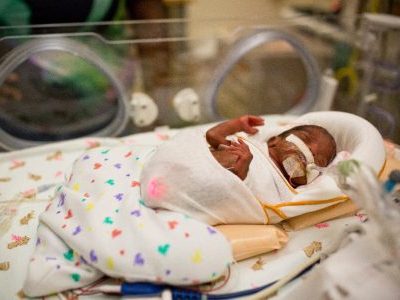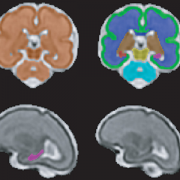Premature birth may alter critical cerebellar development linked to learning and language

Diffusion tensor imaging teases out subtle injury to cerebral and cerebellar white matter that is not evident with conventional MRI, allowing researchers to quantify brain tissue microstructure and classify white matter integrity.
Premature birth can interrupt a key period of brain development that occurs in the third trimester, which has the potential to impact a child’s long-term learning, language, and social skills. A recent case-control study published in The Journal of Pediatrics applied diffusion tensor magnetic resonance imaging (DTI) to zoom in on the microstructures comprising the critical cerebellar neural networks related to learning and language, and found significant differences between preterm and full-term newborns.
“The third trimester, during which many premature births occur, is typically when the developing cerebellum undergoes its most dramatic period of growth. Normally, the cerebellar white matter tracts that connect to the deep nuclei are rich in pathways where nerve fibers cross. Those connections permit information to flow from one part of the brain to another. It is possible that premature birth leads to aberrant development of these critical neural networks,” says Catherine Limperopoulos, Ph.D., director of the Developing Brain Research Laboratory at Children’s National Health System and senior study author.
One in 10 American babies is born prematurely. The brain injury that infants born prematurely experience is associated with a range of neurodevelopmental disabilities, including some whose influence isn’t apparent until years later, when the children begin school. Nearly half of extremely preterm infants go on to experience long-term learning, social, and behavioral impairments.
While conventional magnetic resonance imaging (MRI) can detect many brain abnormalities in newborns, a newer technique called DTI can tease out even subtle injury to cerebral and cerebellar white matter that is not evident with conventional MRI. White matter contains axons, which are nerve fibers that transmit messages. With DTI, researchers can quantify brain tissue microstructure and describe the integrity of white matter.
The research team compared imaging from 73 premature infants born before 32 weeks gestation who weighed less than 1,500 grams with 73 healthy newborns born to mothers who delivered at full term after 37 weeks. After the newborns had been fed, swaddled, and fitted with double ear protection, the imaging was performed as they slept. Nurses monitored their heart rates and oxygen saturation. Their brain abnormalities were scored as normal, mild, moderate, or severe.
All of the full-term newborns had normal brain MRIs as did 44 (60.3 percent) of the preemies.
The preemies had significantly higher fractional anisotropy in the cerebellum, the part of the brain that processes incoming information from elsewhere in the brain, permitting coordinated movement as well as modulating learning, language, and social skills. Alterations in cerebellar microarchitecture was associated with markers for illness severe enough to require surgery – such as correcting abnormal blood flow caused by the failure of the ductus arteriosus to close after birth and to remedy a bowel disease known as necrotizing enterocolitis. The risk factors also are associated with compromised cardiorespiratory function and low Apgar score at five minutes, Limperopoulos and co-authors write. The Apgar score is a quick way to gauge, one minute after birth, how well the newborn withstood the rigors of childbirth. It is repeated at five minutes to describe how the newborn is faring outside of the womb.
“In previous studies, we and others have associated cerebellar structural injury in preterm infants with long-term motor, cognitive, and socio-affective impairments. This is one of the first studies to provide a detailed report about these unexpected alterations in cerebellar microstructural organization,” she adds. “We postulate that the combination of premature birth and early exposure of the immature developing cerebellum to the extrauterine environment results in disturbed micro-organization.”
Additional research is warranted in larger groups of patients as well as long-term follow up of this cohort of newborns to determine whether this microstructural disorganization predicts long-term social, behavioral, and learning impairments.
“A large number of these prematurely born newborns had MRI readings in the normal range. Yet, we know that these children are uniquely at risk for developing neurodevelopmental disabilities later in life. With additional study, we hope to identify interventions that could lower those risks,” Limperopoulos says.
Related resources: The Journal of Pediatrics editorial











